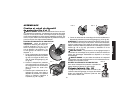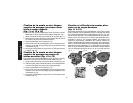
English
7
Precautions To Take When Sanding
Paint
1. Sanding of lead based paint is NOT RECOMMENDED due
to the difficulty of controlling the contaminated dust. The
greatest danger of lead poisoning is to children and pregnant
women.
2. Since it is difficult to identify whether or not a paint contains
lead without a chemical analysis, we recommend the follow-
ing precautions when sanding any paint:
PERSONAL SAFETY
a. No children or pregnant women should enter the work area
where the paint sanding is being done until all clean up is
completed.
b. A dust mask or respirator should be worn by all persons
entering the work area. The filter should be replaced daily
or whenever the wearer has difficulty breathing.
NOTE: Only those dust masks suitable for working with lead
paint dust and fumes should be used. Ordinary painting masks
do not offer this protection. See your local hardware dealer for
the proper N.I.O.S.H. approved mask.
c. NO EATING, DRINKING or SMOKING should be done in
the work area to prevent ingesting contaminated paint par-
ticles. Workers should wash and clean up BEFORE eating,
drinking or smoking. Articles of food, drink, or smoking
should not be left in the work area where dust would settle
on them.
ENVIRONMENTAL SAFETY
a. Paint should be removed in such a manner as to minimize
the amount of dust generated.
b. Areas where paint removal is occurring should be sealed
with plastic sheeting of 4 mils thickness.
c. Sanding should be done in a manner to reduce tracking of
paint dust outside the work area.
CLEANING AND DISPOSAL
a. All surfaces in the work area should be vacuumed and thor-
oughly cleaned daily for the duration of the sanding project.
Vacuum filter bags should be changed frequently.
b. Plastic drop cloths should be gathered up and disposed of
along with any dust chips or other removal debris. They
should be placed in sealed refuse receptacles and disposed
of through regular trash pick-up procedures.
c. During clean up, children and pregnant women should be
kept away from the immediate work area.
d. All toys, washable furniture and utensils used by children
should be washed thoroughly before being used again.
Edge Grinding and Cutting (FIG. 21)
WARNING: Do not use edge grinding/cutting wheels for surface
grinding applications because these wheels are not designed for
side pressures encountered with surface grinding. Wheel breakage
and injury may result.
Edge grinding and cutting can be performed
with type 27 wheels designed and specified
for this purpose. Protect yourself during edge
grinding and cutting by directing the open
side of the guard toward a surface. Edge grinding and cutting
wheels should contact the work surface only at the edge of the
wheel, not on the top or bottom of the wheel. Side pressure on the
wheel could lead to breakage of the wheel.
Type 1 wheels can be used for edge cutting. See the instruction
manual included with the accessory type 1 guard for specific
instructions.
FIG. 21


















